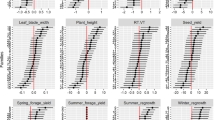Summary
During the years 1973 to 1976 two populations of Pearl millet with wide genetic base, namely, Delhi composite (DC) and Vijay composite (VC) were used to compare the response to selection by the full-sib family method from biparental material and reciprocal recurrent selection (RRS). The results indicated that it was possible to advance grain yield with one cycle of RRS by about 23 percent in the case of population DC and 21 percent in population VC, while for the full-sib selection method, the improvement in grain yield was not so rapid. The studies on the nature of gene action indicated that both additive and dominance gene actions were important for grain yield, ear length and ear girth. The coefficient of variation as a result of RRS was reduced in population DC, while it was comparable to base population in the other population. The correlation studies indicated that the magnitude of favourable correlation of different characters with grain yield were higher in case of RRS compared to the full-sib system. The presence of negative correlation of plant height with grain yield in both the improved populations indicated the possibility of breakage of unfavourable gene combinations through RRS and full-sibs developed from biparental mating.
Similar content being viewed by others
Literature
Badwal, S.S. (1970): Estimation of combining ability in a diallel cross of five selected inbreds of pearl millet. Indian J. Agric. Sci 40, 895–900
Burton, G.W. (1952): The immediate effect of genetic relationship upon seed production in pearl millet. Agron. J. 44, 424–427
Comstock, R.E.; Robinson, H.F. (1948): The components of genetic variance in populations of biparental progenies and their uses in estimating the degree of dominance. Biometrics 4, 255–266
Comstock, R.E.; Robinson, H.F. (1952): Estimation of average dominance of genes. In: Heterosis (ed. Gowen, J.W.), pp. 494–516. Ames, Iowa: Iowa State Coll. Press
Comstock, R.E.; Robinson, H.F.; Harvey, P.H. 1949: A breeding procedure designed to make use of both general and specific combining ability. J. Agron 41, 360–367
Eberhart, S.A.; Moll, R.M.; Robinson, H.F.; Cockerham, C.C. (1966): Epistatic and other genetic variances in two varieties of maize. Crop Sci. 6, 275–280
Gill, B.S.; Phul, P.S.; Rana, N.D. (1969): Diallel analysis of combining ability in a group of lines in pearl millet. J. Res. Punjab Agric. Univ. 6, 591–596
Indian Agricultural Research Institute (1977): Annual Report Production Technology. In: Contributions to a Changing Agriculture, pp. 1–70. New Delhi: IARI
Kanwar, J.S.; Ryan, J.G. (1976): Recent trends in world sorghum and millet production and some possible future developments. Hyderabad: ICRISAT
Lee, C.M.; Yap, T.C. (1975): Reciprocal recurrent selection for grain yield in two varieties of maize. Mal. Agric. Res. 4, 217–222
Murty, B.R.; Upadhyay, M.K.; Manchanda, P.L. (1967 a) Classification and cataloguing of a world collection of genetic stocks of Pennisetum. Indian J. Genet. 27 (Spl. No.), 313–394
Murty, B.R.; Tewari, J.L.; Harinarayan, G. (1967 b): Line × tester analysis of combining ability and heterosis of yield factors in Pennisetum typhoides. Indian J. Genet. 27, 238–243
Pokhriyal, S.C.; Mangath, K.S.; Patil, R.R. (1976): Agronomic traits influencing seed yield in pearl millet. Indian J. Hered 8, 49–52
Rao, J.T.; Krishnamurthy, T.N. (1968): Accelerated genetic improvement in sugarcane. Indian J. Genet. 28 A, 88–96
Sharma, J.R.; Yadav, S.P.; Singh, J.N. (1979): The components of genetic variation in biparental progenies and their use in breeding of pearl millet (Pennisetum typhoides) Burm. S.&H. Z. Pflanzenzucht. 82, 250–257
Singh, B.B. (1974): Expected and realized response to selection in biparental and selfed populations of pearl millet. Indian J. Genet. 34, 405–410
Singh, R.D.; Joshi, A.B.; Dhawan, N.L.; Mukherjee, B.K. (1976): Studies in elite Indian maize composites. 2: Attempts at further improvement using full-sib system of breeding. Genetika 9, 27–35
Singh, B.B.; Murty, B.R. (1973): A comparative analysis of biparental mating and selfing in pearl millet (Pennisetum typhoides Burm. S.&H.). Theor. Appl. Genet. 43, 18–22
Singh, F.; Singh, R.K.; Singh, V.P. (1974): Combining ability studies in pearl millet (Pennisetum typhoides (Burm.) S.&H.). Theor. Appl. Genet. 44, 106–110
Sprague, G.F.; Cockerham, C.C. (1959): Non-allelic gene interactions and interpretation of quantitative genetic data. Tech. Bull. 118. Inst. Stat. Univ. NC
William, J.C.; Penny, L.H.; Sprague, G.F. (1965): Full-sib and half-sib estimates of genetic variance in open-pollinated varieties of corn (Zea may L.) Crop Sci. 5, 125–129
Author information
Authors and Affiliations
Additional information
Communicated by H. F. Linskens
Rights and permissions
About this article
Cite this article
Govil, J.N., Pokhriyal, S.C. & Murty, B.R. Full-sib and reciprocal recurrent selection in relation to pearl millet improvement. Theoret. Appl. Genetics 62, 25–30 (1982). https://doi.org/10.1007/BF00276275
Received:
Issue Date:
DOI: https://doi.org/10.1007/BF00276275




